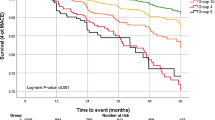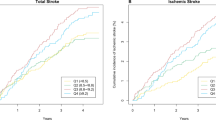Abstract
Background
The Japanese Specific Health Checkup mainly focuses on metabolic syndrome for preventing cardiovascular events. Subjects are stratified by measuring waist circumference, body mass index, blood pressure, triglycerides, and fasting plasma glucose. However, estimated glomerular filtration rate (eGFR) is not considered essential.
Methods
A longitudinal cohort study assessed the association of eGFR with new-onset brain or heart attacks in a large Japanese nationwide Specific Health Checkup database. A total of 109,349 Japanese subjects (mean age 63.2 years, 39.5 % men) were examined for the events 2 years later. The odds ratios were calculated for new events in the total and subgroup populations divided by BMI < or ≥25 kg/m2, obese and non-obese, respectively.
Results
Obese subjects were more often male and had proteinuria (dipstick test ≥1+), lower eGFR, and higher systolic and diastolic BP, fasting plasma glucose, hemoglobin A1c, and triglycerides (TG). Rates of new-onset brain or heart attacks were 3.1 and 4.0 % in the groups of non-obese and obese subjects, respectively. In the total population, eGFR as well as higher BMI (≥25 kg/m2), higher BP (high-normal hypertension or greater), higher TG (≥150 mg/dl), and proteinuria were significant risk factors for developing brain or heart attacks. The eGFR was significant in non-obese subjects, but not in the obese.
Conclusion
As the ultimate aim of ‘Specific Health Checkup’ is to prevent cardiovascular events, our study suggests that eGFR should be evaluated in non-obese subjects.




Similar content being viewed by others
References
http://www.mhlw.go.jp/seisaku/2009/09/02.html (in Japanese).
Kohro T, Furui Y, Mitsutake N, Fujii R, Morita H, Oku S, et al. The Japanese national health screening and intervention program aimed at preventing worsening of the metabolic syndrome. Int Heart J. 2008;49(2):193–203.
Iseki K, Asahi K, Moriyama T, Yamagata K, Tsuruya K, Yoshida H, et al. Risk factor profiles based on estimated glomerular filtration rate and dipstick proteinuria among participants of the Specific Health Check and Guidance System in Japan 2008. Clin Exp Nephrol. 2012;16(2):244–9. doi:10.1007/s10157-011-0551-9.
Nagai K, Yamagata K, Ohkubo R, Saito C, Asahi K, Iseki K, et al. Annual decline in estimated glomerular filtration rate is a risk factor for cardiovascular events independent of proteinuria. Nephrol Carlton. 2014;19(9):574–80. doi:10.1111/nep.12286.
Sato Y, Yano Y, Fujimoto S, Konta T, Iseki K, Moriyama T, et al. Glycohemoglobin not as predictive as fasting glucose as a measure of prediabetes in predicting proteinuria. Nephrol Dial Transplant. 2012;27:3862–8.
Yano Y, Sato Y, Fujimoto S, Konta T, Iseki K, Moriyama T, et al. Association of high pulse pressure with proteinuria in subjects with diabetes, prediabetes, or normal glucose tolerance in a large Japanese general population sample. Diabetes Care. 2012;35(6):1310–5.
Konta T, Hao Z, Takasaki S, Abiko H, Ishikawa M, Takahashi T, et al. Clinical utility of trace proteinuria for microalbuminuria screening in the general population. Clin Exp Nephrol. 2007;11(1):51–5.
American Diabetes Association. Diagnosis and classification of diabetes mellitus. Diabetes Care. 2011;34(Suppl 1):S62–9. doi:10.2337/dc11-S062.
Matsuo S, Imai E, Horio M, Yasuda Y, Tomita K, Nitta K, et al. Revised equations for estimated GFR from serum creatinine in Japan. Am J Kidney Dis. 2009;53(6):982–92.
Stevens PE, Levin A. Kidney disease: improving Global Outcomes Chronic Kidney Disease Guideline Development Work Group M. Evaluation and management of chronic kidney disease: synopsis of the kidney disease: improving global outcomes 2012 clinical practice guideline. Ann Intern Med. 2013;158(11):825–30. doi:10.7326/0003-4819-158-11-201306040-00007.
Schiffrin EL, Lipman ML, Mann JF. Chronic kidney disease: effects on the cardiovascular system. Circulation. 2007;116(1):85–97. doi:10.1161/CIR.106.678342.
Matsuzawa Y, Funahashi T, Kihara S, Shimomura I. Adiponectin and metabolic syndrome. Arterioscler Thromb Vasc Biol. 2004;24(1):29–33. doi:10.1161/01.ATV.0000099786.99623.EF.
Reilly MP, Lehrke M, Wolfe ML, Rohatgi A, Lazar MA, Rader DJ. Resistin is an inflammatory marker of atherosclerosis in humans. Circulation. 2005;111(7):932–9. doi:10.1161/01.CIR.0000155620.10387.43.
Gustafson B, Hammarstedt A, Andersson CX, Smith U. Inflamed adipose tissue: a culprit underlying the metabolic syndrome and atherosclerosis. Arterioscler Thromb Vasc Biol. 2007;27(11):2276–83. doi:10.1161/ATVBAHA.107.147835.
Palatini P, Mormino P, Dorigatti F, Santonastaso M, Mos L, De Toni R, et al. Glomerular hyperfiltration predicts the development of microalbuminuria in stage 1 hypertension: the HARVEST. Kidney Int. 2006;70(3):578–84. doi:10.1038/sj.ki.5001603.
Magee GM, Bilous RW, Cardwell CR, Hunter SJ, Kee F, Fogarty DG. Is hyperfiltration associated with the future risk of developing diabetic nephropathy? meta-analysis. Diabetologia. 2009;52(4):691–7. doi:10.1007/s00125-009-1268-0.
Acknowledgments
This work was supported by Health and Labour Sciences Research Grants for “Research on the Positioning of Chronic Kidney Disease in Specific Health Check and Guidance in Japan” (20230601) from the Ministry of Health, Labour and Welfare of Japan.
Conflict of interest
All the authors declare no competing interests.
Author information
Authors and Affiliations
Corresponding author
About this article
Cite this article
Sato, Y., Fujimoto, S., Konta, T. et al. Significance of estimated glomerular filtration rate in predicting brain or heart attacks in obese and non-obese populations. Clin Exp Nephrol 19, 790–796 (2015). https://doi.org/10.1007/s10157-014-1062-2
Received:
Accepted:
Published:
Issue Date:
DOI: https://doi.org/10.1007/s10157-014-1062-2




